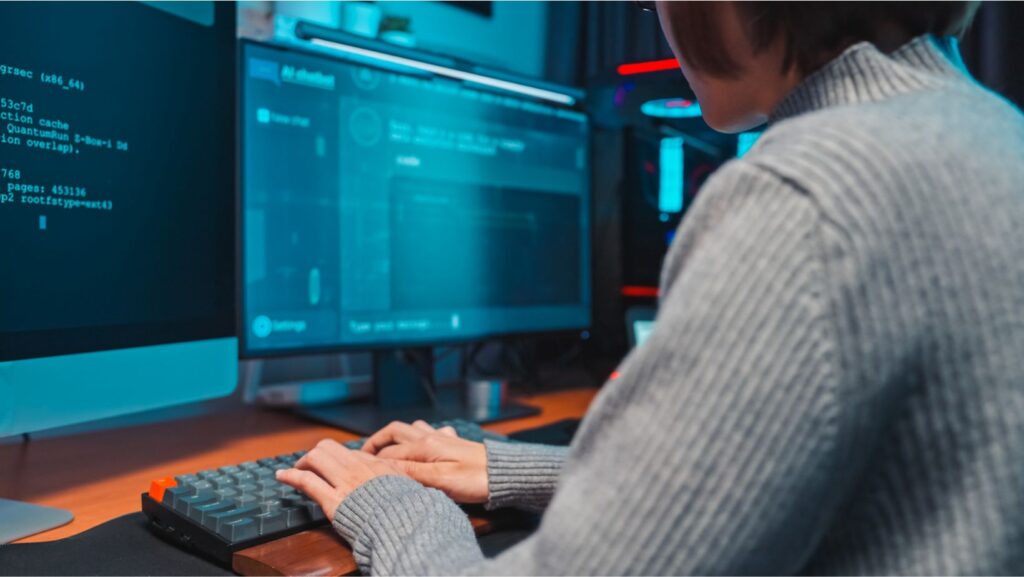As technology continues to advance, it’s no surprise that the role of artificial intelligence (AI) in various industries is growing.
The graphic design industry is no exception.
AI and AI tools have made significant strides in automating certain aspects of graphic design, leading many to wonder if AI is replacing graphic designers altogether.
As a designer, do you need to worry about your job?
Is AI replacing graphic designers, and could you be replaced by these supercomputer geniuses?
The answer is no.
While AI is eliminating the need for certain graphic design jobs, and changing the landscape of the industry, it cannot replace the need for the graphic designer himself.
While MOCK, the Agency may incorporate AI to help with certain tasks, ultimately we believe design is an inherently human element that a computer can never truly replace.
The truth is, AI is taking over some graphic design tasks
It’s true that AI IS starting to take on some tasks traditionally performed by designers.
For example, there are now AI-powered tools that can generate logos, designs, and even entire websites with just a few clicks.
These tools use complex algorithms to analyze trends, colors, and layouts, creating visually appealing designs in a fraction of the time it would take a human designer.
How AI is changing graphic design?
One of the most significant impacts AI tools have had on the design industry is in the automation of repetitive tasks.
Designers no longer need to spend hours manually resizing images or creating multiple versions of a design for different platforms.
AI can handle these tasks quickly and efficiently, freeing up designers to focus on more creative and strategic aspects of their work.

AI is also revolutionizing the field of data visualization.
With vast amounts of information available, designers can use AI algorithms to analyze and present data in visually compelling ways.
This allows for the creation of interactive infographics and visualizations that engage viewers and convey complex ideas effectively.
Additionally, AI is enhancing the efficiency of the design process.
Machine learning algorithms can analyze user feedback and preferences, allowing designers use both AI and software to create personalized designs and experiences.
This level of customization was previously time-consuming and challenging to achieve.
Will AI replace the designer?
While AI is undoubtedly making an impact in the graphic design industry, it doesn’t mean that graphic designers will be rendered obsolete.
The truth is, AI cannot replace the unique qualities that human designers bring to the table.
Design is not just about creating aesthetically pleasing visuals; it’s about telling a story, evoking emotions, and creating a connection with the audience.
These are aspects that require human imagination, mental capacity, and emotional understanding – qualities that AI cannot replicate.
The creative process involves ideation, experimentation, and intuition, all of which are deeply rooted in the human experience.
Designers possess a critical eye for detail, an understanding of composition and color, and the ability to think outside the box.
These skills and attributes CANNOT be replaced by AI.

Will graphic designers be needed in the future?
Absolutely!
As AI tools continue to evolve and become more sophisticated, the role of graphic designers will adapt and evolve as well.
Rather than being replaced, designers have the opportunity to LEVERAGE AI as a powerful tool in their creative process.
Graphic designers who are willing to embrace new technologies and learn how to work alongside AI will find themselves in high demand.
By understanding AI’s capabilities and limitations, designers can leverage its strengths to enhance their own work.
In fact, AI can be seen as a complement to graphic design rather than a threat.
Designers can use AI-powered tools to automate tedious tasks, streamline workflows, and generate initial concepts.
This allows designers to focus on the essential aspects of their work, such as concept development, client collaboration, and refining design solutions.
Will AI replace UX designers?
AI will not replace graphic design jobs entirely.
Like I said about graphic design, AI cannot replace the specialized skills and insights that UX designers bring to the table.
UX design involves understanding human behavior, conducting user research, and creating intuitive and engaging experiences.
These are areas where human designers excel.
You can’t think like a person unless you ARE a person.

AI vs UX design: Is AI enough?
AI undoubtedly brings valuable assistance to the realm of UX design, particularly in areas like data analysis, user behavior prediction, and even prototyping.
However, it’s important to remember that AI is, at its core, a programmed system.
It can ONLY do what it’s been designed to do, within the limits of its programming.
AI lacks the ability to truly understand and empathize with the human experience, an essential element in UX design.
Creativity, experience, and human ingenuity are irreplaceable aspects of successful UX design.
People are capable of original thinking, of understanding nuanced emotions, and of empathizing with users on a deep, emotional level.
They can leverage their creativity to devise unique solutions to problems, something that a pre-programmed AI cannot accomplish.
In essence, while AI can assist and augment the work of UX designers, it cannot fully replace the human touch that is so critical to creating truly meaningful and engaging user experiences.
Generative AI and small business
Generative AI presents an array of opportunities for small businesses to streamline their processes, enhancing efficiency and profitability.
The technology can automate repetitive tasks, freeing up valuable time for business owners to focus on strategic planning and growth.
For instance, AI-powered tools can generate detailed and customized reports, manage business inventory, and even handle customer service inquiries.
Furthermore, generative AI can enable a small business to create personalized marketing campaigns.
The technology can analyze customer data and identify trends, enabling businesses to target their marketing efforts more effectively.
Instead of spending hours analyzing data and crafting individualized messages, AI can dramatically cut down the time and effort required, allowing small businesses to compete on a larger scale.
The human element of design
AI has undeniably made significant strides in the field of design, taking on tasks such as data analysis, prototyping, and even content generation.
This technology can analyze vast amounts of data quickly, generate initial design concepts, and automate repetitive tasks, thereby increasing efficiency and productivity.
But despite these advancements, AI cannot entirely replace graphic designers.
This is because design is an inherently human-centric activity that involves UNDERSTANDING the complex nuances of human emotion, intuition, and experience.

It’s about creating meaningful experiences that resonate with people on a personal and emotional level, something that AI, with its current capabilities, cannot accomplish.
Human designers possess an innate understanding of aesthetics, culture, and the emotional subtleties of their audience, allowing them to create designs that connect, engage, and inspire.
This level of empathy, intuition, and creativity, which is at the heart of successful design, is something that AI cannot replicate.
That is why AI may never replace human creativity.
UX designers play a VITAL role in understanding users’ needs, conducting usability tests, and iterating designs based on feedback.
AI can support these processes by providing data analysis and insights, but it cannot replace the human element of empathy and understanding.
AI is undoubtedly transforming the graphic design industry.
Will AI replace designers?
However, graphic designers need not fear being replaced by AI.
By embracing new technologies and continuously expanding their skill set, designers in a creative agency CAN remain at the forefront of their field and continue to deliver unique and impactful designs that AI alone cannot replicate.
The future of graphic design lies in collaboration between humans and AI, where both can leverage their strengths to create remarkable and engaging visual experiences.


Comments are closed.